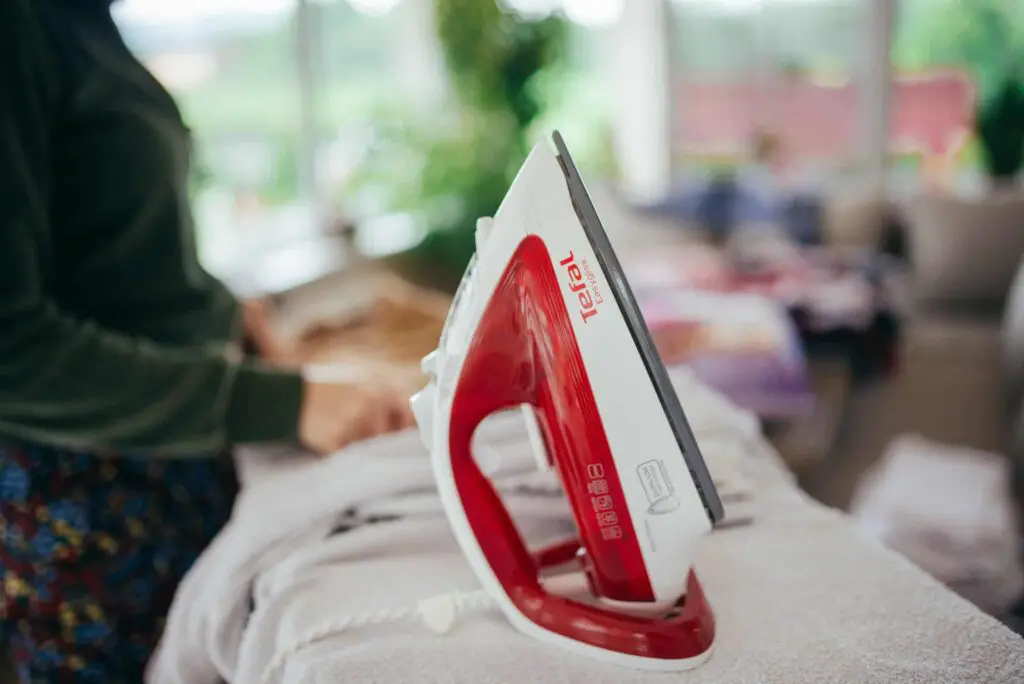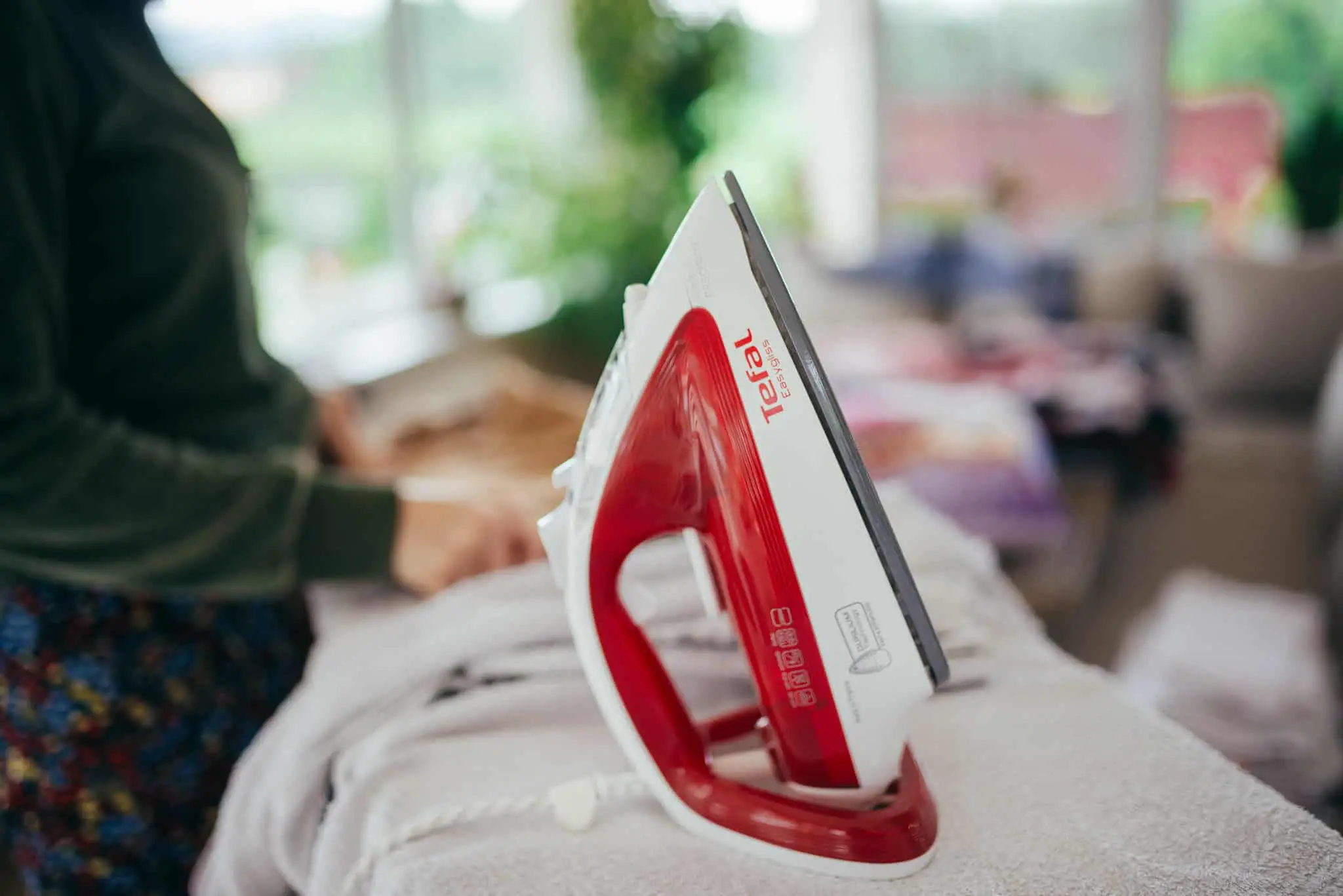Tefal (portmanteau of TEFlon and ALuminium) is a French cookware and small appliance manufacturer which catalogs high-quality ironing products.
Steam-Irons are now ingrained within our day-to-day lives that it’s not uncommon to encounter issues.
[ez-toc]

Tefal Steam-Iron Common Problems
Here are a few of the most common Steam-Iron problems and how to resolve them:
1. The Iron Leaves Marks on the Clothes (Spotting)
Spotting or stain marks are a common occurrence; ranging from yellow, brown, or white stains left on your clothes. This inconvenience can be caused by several factors.
Potential Causes & Solutions:
- Dirty Soleplate
Over time and with each use, the soleplate of your iron may become dirty. This accumulated dirt in the iron’s cells may stain the fabric.
(for Durilium soleplates) to fix this, you need to clean it using a damp non-metallic sponge while it’s still warm. You can also use the stick which is made specifically for cleaning the Durillium soleplates
(for Stainless Soleplate) clean with a damp cloth or a non-abrasive sponge.
(for Auto-clean Soleplate) to avoid damaging the surface of the warm soleplate, it is recommended that you use a soft damp cloth. (Warning: Always remember to unplug your appliance first and wait until it’s cooled off before doing this)
- Scaled Iron
Another factor that can cause yellow stain streaks is Lime Deposits.
Never use any descaling agent or vinegar when rinsing the boiler as they could damage it.
Firstly, remove the anti-scale valve and then soak it for four hours in a cup of white vinegar or plain lemon juice. Then rinse it with water after, before putting it back. (Warning: Never touch the end of the anti-calc Valve)
- Overfilling
Sometimes it’s not the devices’ fault but how the consumer uses it.
Overfilling the water tank has also been reported to sometimes lead to spotting, to avoid this mistake just fill it right before you reach the recommended max level.
2. Overheating Steam-Iron
If the soleplate of your steam iron appears to be heating up much more than the intended temperature setting you set it to, one or more components in your appliance are most likely defective.
Potential Causes & Solutions:
- Defective Adjustable Thermostat
The adjustable thermostat is the device that lets you dictate the appropriate temperature level for the clothes you want to iron.
If the thermostat gets faulty, your steam iron will likely start becoming very hot (even if you try to set it to the minimum temperature, the steam iron will overheat and potentially burn your clothes).
When this does start to happen, you would need to inquire a professional and have it replaced.
- Temperature Select Button isn’t Working Properly
Over time, the temperature button can become damaged. You use/turn it, but it won’t send the information to the thermostat below because it’s broken or has worked loose.
If this happens to your device, gently pull on it (via tweezers or pliers) to see what condition it’s in. If it doesn’t have any visible device damage, you can buy the same specific model button and replace it yourself.
On certain rare scenarios where the button is completely stuck or even melted, you can try to pry it open but in cases like this, it’s highly suggested to inquire a professional as it may have further internal damage.
- Faulty Steam Control Thermostat
The control thermostat regulates the temperature of the heating element that produces steam. The steam iron will likely overheat (or not heat up at all) if it is broken, resulting in more steam than usual.
Consult a professional (might need to be replaced).
3. Iron Not Heating
Unlike the previous problem, your steam iron not heating up doesn’t only stem up from the main components but can also be caused by faulty Cords and Electrics.
Potential Causes & Solutions:
- Damaged Power Cord
The possibility is that the steam iron’s power cord could be damaged rendering the steam iron inoperable.
Disconnect the appliance and inspect the power cord for any damage, such as a cut. If there are signs of damage simply replace it (cords needed usually depend on the appliance’s model)
- Faulty Steam Control Thermostat
The control thermostat regulates the temperature of the heating element that produces steam. It can cause the steam iron to not heat up at all (or overheat).
Consult a professional (might need to be replaced)
- Fault in Electrics
If your cord seems fine then the fault might fall upon the electrics (plug socket or the switchboard)
You can test this by using certain devices (multimeter, etc.)
4. Steam Iron isn’t Producing Steam
This happens when the water you use is ‘hard’ and contains minerals that can build up in your iron’s lines, cells, and vents. Which would obstruct the iron’s steam discharge, and sometimes even results in dripping.
Potential Causes & Solutions:
- The Pump has Failed
The pump is what provides the water to the steam generators heating element.
Water won’t be able to enter the element if it suddenly stopped working, and as a result, no steam would be produced.
The pump will need to be replaced if it has failed.
- Blocked Solenoid Valve
The solenoid is an electric valve that maintains the steam inside the heating element at a constant pressure.
The solenoid begins to operate the moment you press the steam button, the solenoid will not be able to open if the switch is defective and your appliance will not produce steam as a result.
You’ll need to replace the switch if that’s the case.
If that isn’t the case, you’ll need to get a new solenoid valve.
Tefal Steam Iron Pros & Cons
Steam Irons have been around for a while and have been regarded as an innovative improvement to the typical Dry Irons.
But with consistent adaption and several releases of newer and newer Steam Iron models and Brands, what are the upsides and downsides of using the Tefal brand.
When deciding which Steam Irons would be the most worth for your buck there are 7 main considerations to think about; Quality of the product, Warranty, Safety aspects, Power consumption, After-sale service, and of course the cost of the product.
Pros:
When talking about what separates Tefal from the competition, the answer is its wide-ranged catalog of Steam Irons to choose from.
16 types of Steam Irons from Tefal all have their own “specialty” and quality of life features (a retractable cord, non-stick coating, self-cleaning, steam-regulating knob, etc.) that differ from model to model, with each model ready to satisfy any need that the consumer deems important.
If you’re the type of person that wants to lower their electrical consumption, Tefal has the model FV1721 for you, an eco-master that lowers electrical consumption.
Do you want a model that has a high Safety rating with an unreasonable Warranty? Say no more, Tefal Ultimate Pure has a 10-year guarantee plus a safety auto-off feature that turns the model off after 30 seconds when left horizontally idle, and eight minutes when left vertically idle.
You’re looking for a model with a high anti-calc feature? Tefal has FV9788 & SV8055 for you, the list just keeps going on, whatever you’re looking for it’s a high chance they have it.
Cons:
One of Tefal’s downside is that with having so many models come the lack of the After-sale service (brought to light by online forums).
It has become a tall task to always have the model-specific necessary part whenever the customers come for repairs.
How Long Should a Tefal Steam Iron Last?
Tefal Ultimate Pure does have a 10-year guarantee. It’s not much of an answer but it does show you how confident they are about the material quality of their product.
A Steam Irons’ life expectancy differs from owner to owner and depends highly on whether it’s properly used and maintained.
Since they don’t have that many moving parts, it’s usually due to a lack of maintenance or failure to use the correct setting when something goes wrong.
It is said that a bond shouldn’t be measured by the spanned length of time but by the caliber of each memorable interaction.
A Tefal Steam Iron might outlast a normal Steam Iron by years or it might outlast it by only a couple of weeks, but at the end in which pair of handles would you rather spend that time ironing, a normal set of steam Iron handle or on a Tefal palm-fitted button-cushioned handle?
Is it Worth Repairing a Tefal Steam Iron?
Yes, performing some minor maintenance and repairs on the steam iron will allow it to return to normal operation.
Although, we can’t rule out the fact that later on, there will come a time when the expense of fixing it can and eventually would outweigh the cost of just buying a new Steam Iron. When that time comes it would be better to just purchase a new one.
With all models having their individual set year-warrantees it would be a waste not to make use of that service, the few days delay (Tefal Steam Iron Pros & Cons) that comes with waiting for the model-specific materials to be shipped is worth as you’d have your appliance fully fixed for free.
Tefal Steam Iron Alternative
If you’re looking for an alternative to Tefal Steam Irons nothing comes comparably close to Philips Steam Irons. Both have been in the market for decades and have earned quite a good reputation for their products.
Both have the basic following features; A rotary control dial to set the desired temperature, for different clothes like cotton, wool, silk, linen. A Built-in Thermostat is used to keep the pre-set temperature constant.
The two also have a three-wire shielded cable used to connect to the power source that should be made of a heat-resistant material such as silicon rubber.
Lastly, both have a spring within the cord end on the iron side to keep it from getting too hot while ironing or sitting vertically at rest.
Resources:
tefal.com, Tefal Appliances

